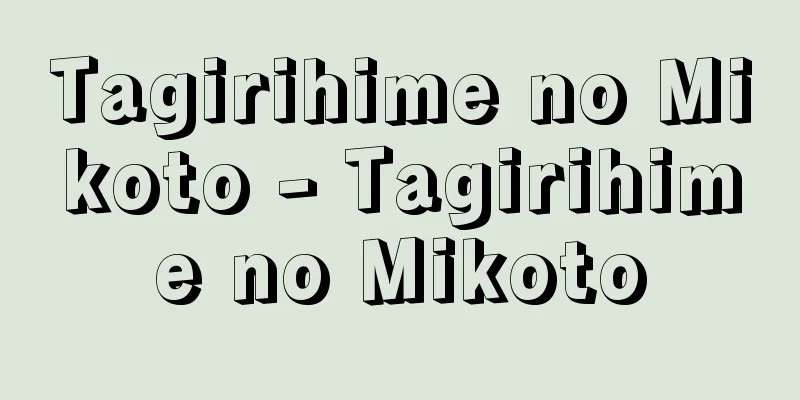Frozen food - Reitoushokuhin (English spelling) frozen food

|
This refers to food that has been frozen to give it a long shelf life. The Japan Frozen Food Association's voluntary handling standards define frozen food as "food that has been pre-processed, quickly frozen to a temperature of -18°C or below, and packaged for sale to consumers (including large-scale consumers) as is." The Food Sanitation Act also stipulates standards for viable bacteria count, processing standards, and storage standards (packaged and stored at -15°C or below). However, frozen fish, meat, fruit, eggs, and other processed ingredients are called "frozen products" and are distinguished from "frozen foods." The process of preserving food by freezing it is generally called freezing. [Tomomi Kono and Yonago Yamaguchi] historyFreezing food to preserve it originates from the ancient wisdom of the Eskimos, who used natural low temperatures to freeze food. It was not until the 16th century that it became possible to freeze food by artificially creating low temperatures using refrigerants. The first freezer was developed in England in 1834, and Frenchman Charles Tellier attempted to freeze beef and lamb, transporting them frozen between France and Argentina in 1877 and 1878. By 1880, frozen transport of livestock meat from Australia and New Zealand to England and France had become practical. Freezing of fish was developed in the United States in the 1860s, and salmon was successfully transported frozen to England. In the 1900s, World War I promoted the advancement of freezing technology, and a quick freezing method was developed that was different from the slow freezing method that had been used up until then. As a result, high-quality frozen foods began to be produced. It is said that the first person to produce frozen fish in Japan was Nakahara Kota, who returned from the United States in 1909 (Meiji 42). It was Kuzuhara Raihei who started the food business, producing frozen fish in Hokkaido in 1918 (Taisho 9). Frozen fish went on sale in department stores in Tokyo and Osaka in 1935 (Showa 10), but was unsuccessful. The freezing method used in Japan at that time was the slow freezing method. After World War II, freezing methods were improved, and frozen foods became popular, mainly for commercial use in school lunches and restaurants, but it was not until the 1960s that they began to be used in ordinary households. A characteristic of frozen food consumption in Japan is that it is centered on prepared foods rather than ingredients such as meat, fish, and vegetables. [Tomomi Kono and Yonago Yamaguchi] Manufacturing methodThe quality of frozen foods improved significantly as the method changed from the early slow freezing method, which involved slowly freezing the food, to the later rapid freezing method. The difference between the two is the amount of drip (liquid) that comes out when the food is thawed. Compared to the slow freezing method, the rapid freezing method produces very little drip. Drip comes out because tissues and cells were destroyed during freezing, which can cause loss of flavor, changes in texture, and deformation. With the slow freezing method, it takes time for the food to pass through the temperature range from where it begins to freeze (freezing point) to where the center of the food is frozen (maximum ice crystal formation zone). This causes the ice crystals to grow large and destroy cells and tissues. On the other hand, with the rapid freezing method, the ice crystals are so fine that they fit inside the cells, causing less tissue damage. There are several freezing methods, the main ones being as follows: (1) Contact freezing method: This is a method of freezing food by directly contacting it with a cooled metal plate. This method can achieve temperatures as low as -40°C. (2) Air blast freezing: This method involves blowing cold air onto the food to freeze it. Temperatures between -35°C and -40°C are used, and this is the most commonly used method in Japan. (3) Immersion freezing: This is a method of freezing food by immersing it in a refrigerant. It is used for chicken and turkey. (4) Freezing with liquefied gas This method uses the ultra-low latent heat of vaporization obtained when liquefied gases such as liquid nitrogen, liquefied carbon dioxide, and liquefied natural gas evaporate to freeze food, allowing temperatures as low as -196°C for liquid nitrogen, -79°C for liquefied carbon dioxide, and -162°C for liquefied natural gas to be used. This method is costly, but the freezing time is very short and high-quality frozen foods can be obtained. In terms of the form of freezing, there is block freezing, where the material is frozen in batches of a certain size, and individual loose freezing. [Tomomi Kono and Yonago Yamaguchi] kindsThe most widely produced vegetables are sweet corn, pumpkin, French fries, green peas, spinach, mixed vegetables (corn, carrots, green peas), kidney beans, and edamame. If vegetables are frozen raw, they will turn brown and their fibers will harden. For this reason, they are lightly heated in steam or boiled water beforehand. This is called blanching. To thaw, they are quickly boiled while frozen, fried, simmered, deep-fried, or otherwise heated. The main fruits are strawberries and mandarin oranges, but also melons, pineapples, and peaches. They are also processed into fruit cocktails, fruit sauces, fruit juices and purees, and fruit preserved in syrup. Frozen fruits are mainly used as ingredients for juice made in commercial mixers, and are also used as processed ingredients for sweets and ice cream. When used as a dessert, they are eaten half-thawed for a smooth texture. Frozen fish are classified into round (whole), semi-dressed (gills and internal organs removed), dressed (head and tail removed), fillet (cut into three pieces), filleted, filleted, peeled (shellfish, shrimp), etc. Processed fish with breadcrumbs, grilled eel, pickled fish, and paste products are classified as frozen prepared foods. Frozen fish is the main frozen food in Japan, and plays a major role in preserving freshness, preserving, and transporting fish in deep-sea fishing and aquaculture. Frozen fish and shellfish are prone to changes during storage, such as denaturation of proteins and oxidation of fats. In particular, oxidation of fats can easily deteriorate the flavor, so packaging is often done in a creative way, or a process called glazing is used, in which a layer of ice is applied to the entire surface of the fish. In principle, fish and shellfish are thawed naturally (slow thawing in a refrigerator, etc.), but small fillets and peeled fish can be used frozen when cooking by boiling or simmering. When preparing tuna for sashimi, thaw it naturally at a low temperature, cut it while it is still partially thawed, and eat it immediately. If it is thawed too long, it will drip and the color will change. Livestock products are available in the form of carcasses for distribution, slices, minced meat, etc. for general consumption. Poultry meat is divided into parts, and frozen eggs are cracked and there are three types of frozen products: whole eggs, egg yolks, and egg whites, which are mainly used as ingredients in confectionery. Egg yolks denature when frozen, so sugar, salt, etc. are added. Meat is generally defrosted slowly at low temperatures and naturally. Consumption of frozen prepared foods has grown rapidly since around 1970, accounting for 70% of all frozen foods in the late 1970s, exceeding 80% since 1994, and reaching 83% in 1999. About half of frozen prepared foods are fried foods (fried shrimp, fried fish, croquettes, cutlets, etc.), followed by shumai, gyoza, and hamburgers. There are also a wide variety of other frozen prepared foods, including Chinese steamed buns, chawanmushi, kabayaki, rice dishes, noodles, and pies. Frozen prepared foods are not only foods that save time at home, but are also developed as multipurpose foods such as luxury items and special-purpose items such as medical foods, and are often used in the food service industry. Thawing and usage methods vary depending on the food. [Tomomi Kono and Yonago Yamaguchi] Quality changeWhen frozen foods are frozen, the moisture content is fixed, which is why they are less susceptible to spoilage by microorganisms. However, freezing is not sterilization, so it is important to reduce the number of bacteria before freezing. This is regulated by the standards of the Food Sanitation Act and the hygiene guidelines of prefectures. The nutritional value of frozen foods is only lost during preparation, and changes during freezing and storage are relatively small. However, fats and oils gradually oxidize during storage, which can be a problem in terms of flavor. The most important changes in quality are flavor, color, shape, texture, and other elements. The quality of frozen foods depends on the conditions during production (ingredients, processing, packaging) and the conditions during distribution and storage after production (time, temperature). In other words, even if the conditions before production are good, the quality is greatly affected by the cold chain conditions during distribution and how it is handled after it reaches the consumer. Moreover, it is difficult to set quality standards based on appearance, and it is a major problem to determine the acceptable limit of quality change. In order to obtain good quality frozen foods, ordinary consumers should pay attention to the following points: (1) At the time of purchase, the storage temperature in the showcase must be below -18°C (below -15°C under the Food Sanitation Act). In addition, even if fish or meat is brought to a fishing port as frozen fish, if it is not kept in a freezer case during transportation and sale, it is treated as fresh fish and is not considered frozen food. [Tomomi Kono and Yonago Yamaguchi] "Understanding Frozen Foods, by Noguchi Satoshi (1997, Maruzen)" ▽ "New Food Encyclopedia 9: Processed Foods and Frozen Foods, edited by Kono Tomomi (1999, Shinju Shoin)" ▽ "Encyclopedia of Frozen Foods, supervised by the Japan Frozen Food Association (2000, Asakura Shoten)" ▽ "This is what happened: A side history of the development of frozen foods, by Hisa Tsutomu (2000, Frozen Food Newspaper)" ▽ "Introduction to Frozen Foods, revised and expanded edition, supervised by the Japan Frozen Food Association (2004, Japan Food Newspaper)" ▽ "The Story of Frozen Foods: A History of Product Evolution, 3rd Edition (2004, Frozen Food Newspaper)" [Reference] | | | |Source: Shogakukan Encyclopedia Nipponica About Encyclopedia Nipponica Information | Legend |
|
冷凍加工して長期の保存性をもたせた食品をいう。日本冷凍食品協会の自主的取扱基準における冷凍食品の定義は「前処理を施し、品温が零下18℃以下になるように急速凍結し、通常そのまま消費者(大口需要者を含む)に販売されることを目的として包装されたもの」となっている。また、食品衛生法では生菌数の規格や加工基準、保存基準(包装して零下15℃以下で保存)を規定している。しかし、加工素材として利用される冷凍魚、冷凍肉、冷凍果実や冷凍卵などは「冷凍品」とよび、「冷凍食品」と区別されている。なお、冷凍食品にして食品を保存することを一般にフリージングとよんでいる。 [河野友美・山口米子] 歴史食品を凍結させて保存することは、古くからエスキモーなどが天然の低温を利用し、食料を氷結させて用いた生活の知恵に由来する。寒剤などを用いて人工的に低温をつくりだし、食品を凍結することができるようになったのは16世紀になってからである。最初の冷凍機は1834年イギリスで開発され、フランス人シャルル・テリエCharles Tellierが牛肉や羊肉の冷凍を試み、1877年と78年にフランス―アルゼンチン間の冷凍輸送を行った。1880年ごろにはオーストラリアやニュージーランドからイギリスやフランスへの畜肉の冷凍輸送が実用化している。魚類の冷凍については1860年代にアメリカで開発され、イギリスへサケの冷凍輸送を成功させた。1900年代になって第一次世界大戦が冷凍技術の進歩を促進させ、それまでの緩慢凍結法とは違う急速凍結法が開発された。その結果、品質のよい冷凍食品がつくられるようになった。 日本では1909年(明治42)にアメリカから帰国した中原孝太が冷凍魚をつくったのが最初だとされている。食品事業として始めたのは葛原猪平(くずはらいへい)で、20年(大正9)に北海道で冷凍魚を製造している。35年(昭和10)に東京と大阪のデパートで冷凍魚が発売されたが不調に終わった。この時代の日本の冷凍法は緩慢凍結法であった。第二次世界大戦後、冷凍法も改良され、学校給食やレストランなど業務用を主体として冷凍食品が普及していったが、一般家庭でも使用されるようになったのは昭和40年代である。日本での冷凍食品消費の特徴は、肉、魚、野菜といった素材よりも調理食品が中心になっていることである。 [河野友美・山口米子] 製造方法冷凍食品は、初期のゆっくりと凍結する緩慢凍結法から、のちに急速凍結法に変化することによって、品質が著しく向上した。この両者の違いは、解凍したときに出るドリップ(液汁)の量の差である。緩慢凍結法に比べ、急速凍結法ではドリップの流出はたいへん少ない。ドリップが出るということは、凍結中に組織や細胞が破壊されたためで、うまみの流失や歯ざわりの変化、形くずれなどの原因となる。緩慢凍結法では、食品が凍り始める温度(凍結点)から、食品の中心部まで凍結するまでの温度帯(最大氷結晶生成帯)を通過するのに時間がかかる。そのため、氷の結晶が大きく成長し、細胞や組織を破壊することになる。一方、急速凍結法だと氷の結晶が微細であるため、細胞内に氷の結晶が納まるので、組織の破壊が少なくてすむ。 凍結法にはいくつかの方法があり、おもなものをあげると次のとおりである。 (1)接触板式凍結法(コンタクト凍結法) 冷却された金属板に食品を直接接触させて凍結する方法。零下40℃付近の低温が得られる。 (2)エアーブラスト凍結法 冷風を食品に当てて凍結するもので、零下35~零下40℃の温度帯が用いられ、日本でもっとも一般に利用されている方法である。 (3)浸漬(しんし)式凍結法 食品を冷媒の中に浸漬して凍結する方法で、鶏肉や七面鳥に利用されている。 (4)液化ガスによる凍結法 液体窒素、液化炭酸ガス、液化天然ガスなどの液化ガスが蒸発するときに得られる超低温の気化潜熱を利用して凍結するもので、液体窒素を用いると零下196℃、液化炭酸ガスでは零下79℃、液化天然ガスで零下162℃という低温が使える。この方法はコストがかかるが凍結時間がたいへん短く高品質の冷凍食品が得られる。 凍結の形からは、一定のサイズにまとめて凍結するブロック凍結と、個別のバラ凍結とがある。 [河野友美・山口米子] 種類野菜類で生産量の多いのはスイートコーン、カボチャ、フレンチフライドポテト、グリーンピース、ホウレンソウ、ミックスベジタブル(コーン、ニンジン、グリンピース)、インゲンマメ、枝豆などである。野菜は生のまま凍結すると褐変し、繊維が固くなる。そのため、あらかじめ蒸気または熱湯で軽く加熱処理をする。これをブランチングという。解凍は、凍ったまま急速にゆでる、炒(いた)める、煮る、揚げるなど加熱して行う。果物はイチゴ、ミカンがおもで、そのほかメロン、パイナップル、モモなどがある。また、加工されたフルーツカクテル、フルーツソース、果汁やピューレ、シロップ漬けなどもある。冷凍果実の用途はおもに業務用のミキサーでつくるジュースの原料で、そのほか菓子やアイスクリームの加工原料として用いられる。デザートとして利用する場合は半解凍程度で食べると口あたりがよい。 冷凍魚は原材料の処理形態から、ラウンド(まるごと)、セミドレス(えらと内臓を除去)、ドレス(頭、尾も除去)、フィレー(三枚おろし)、切り身、開き、むき身(貝、エビ)などがある。加工したパン粉つきや蒲(かば)焼き、酢じめ、練り製品などは冷凍調理食品に分類される。冷凍魚は日本での主要な冷凍食品で、遠洋漁業や養殖での鮮度保持、保存や輸送に大きな役割を果たしている。魚貝類の冷凍食品は保存中に変化してタンパク質の変性、脂肪の酸化などが生じやすい。とくに脂肪の酸化は風味を落としやすいので、包装をくふうしたり、グレーズ加工(グレージング)といって魚の表面全体に氷の層をつけることを行う。魚貝類の解凍は原則として自然解凍(冷蔵庫内などで緩慢解凍を行う)であるが、切り身やむき身など小形のものをゆでる、煮るなどの加熱調理をするときには凍ったまま用いる。マグロの刺身用の場合にはなるべく低温で自然解凍し、半解凍で切ってすぐ食べるようにする。解凍しすぎるとドリップが出たり、色調が変化する。 畜産物では流通用として枝肉が、また一般消費用にスライス、ひき肉などの形態がある。鳥肉では部位に分けたもの、凍結卵では割卵し、全卵、卵黄、卵白の3種の凍結品があり、主として製菓などの原料に用いられる。卵黄は凍結により変性するので、砂糖、食塩などを加える。肉類の解凍は原則として低温でゆっくりと自然解凍を行う。 冷凍調理食品は、1970年(昭和45)前後から急速に消費の伸びてきた食品で、70年代後半には全冷凍食品の70%を占め、94年以降は80%を超し、99年には83%を占めるに至った。冷凍調理食品では約半量がフライ類(エビフライ、魚フライ、コロッケ、カツなど)で、ついでシューマイ、ギョウザ、ハンバーグが上位を占める。そのほか中華まんじゅう、茶碗(ちゃわん)蒸し、蒲焼き、米飯類、麺(めん)類、パイ類と多種のものがある。冷凍調理食品は家庭での手間を省ける食品としてだけでなく、高級品、治療食のような特殊用途品など多目的のものが開発され、外食産業での利用も多い。解凍や利用法は各食品によって異なる。 [河野友美・山口米子] 品質の変化冷凍食品は凍結することによって含有する水分が固定された状態になり、これが、微生物による腐敗のおこりにくい理由である。しかし、凍結は殺菌ではないので、凍結前に菌を少なくすることが重要である。この点については、食品衛生法の規格基準や都道府県の衛生指導基準によって規定されている。 冷凍食品の栄養価値は下処理での損失だけで、凍結処理および保存中の変化は比較的少ない。ただし、油脂に関しては保存中にも酸化が徐々に進行するので、この点は風味上も問題となる。品質の変化のなかで重要なのは風味や色沢、形態、食感などの要素である。 冷凍食品の品質は製造時の条件(材料、加工、包装)および、製造後の流通、貯蔵における条件(時間、温度)に左右される。すなわち、製造前の条件が整っていても、流通時のコールド・チェーンの条件や消費者に届いてからの扱い方で大きく品質が左右される。しかも、外観上、品質の判断基準が設定しにくいうえに、どの程度の品質変化を許容限度とするかが大きな問題となっている。 よい品質の冷凍食品を入手するために、一般消費者としては以下の点に注意する。 (1)購入時にはショーケースの保存温度が零下18℃以下(食品衛生法では零下15℃以下)であること なお、冷凍魚として漁港にあげられた魚や冷凍肉でも、輸送、販売時に冷凍ケース内で行われないものは、鮮魚扱いとなり、冷凍食品としては扱わない決まりがある。 [河野友美・山口米子] 『野口敏著『冷凍食品を知る』(1997・丸善)』▽『河野友美編『新・食品事典9 加工食品・冷凍食品』(1999・真珠書院)』▽『日本冷凍食品協会監修『冷凍食品の事典』(2000・朝倉書店)』▽『比佐勤著『こんなこともあった 冷凍食品発展の側面史』(2000・冷凍食品新聞社)』▽『日本冷凍食品協会監修『冷凍食品入門』改訂増補版(2004・日本食糧新聞社)』▽『『冷凍食品物語 商品の変遷史』第3版(2004・冷凍食品新聞社)』 [参照項目] | | | |出典 小学館 日本大百科全書(ニッポニカ)日本大百科全書(ニッポニカ)について 情報 | 凡例 |
<<: Lingnan - Reinan (English spelling)
>>: Refrigerating machine - Reitou-ki (English spelling) refrigerating machine
Recommend
Prime Minister of the Right
Name: (also "Ujosho") The Chinese name f...
Kizakihara - Kizakibaru
...The center of the city is the long and narrow ...
Prey
A mystery novel by American author Ross Thomas (19...
Reticulated coral crab - Reticulated coral crab
...The walking legs are strong, and the tips of t...
Kazuji Nakamura
Year of death: July 17, 1600 (August 25, 1600) Yea...
side lobe
...This shows how radiation changes depending on ...
"Autumn Fall" - Akikeisei
...Most of the Keiseimono are Nagauta, and many o...
Pumice tuff
A type of glassy tuff. Chemically, it is composed ...
National Labor Union - Kokuro
Its official name is the National Railway Workers&...
Gentleman's Magazine
…This magazine, edited by the writer Jean Donneau...
CID - CID
Character ID : A number uniquely assigned to each ...
Rajgir (English spelling)
…It was the capital of the ancient Indian kingdom...
Picture Matching
[1] 〘Noun〙① A type of game from the Middle Ages. T...
Melissos (English spelling)
Born around 480 BC in Samos [Died around 400 BC] A...
Lawson, HJ
…However, because the ordinary type was dangerous...









